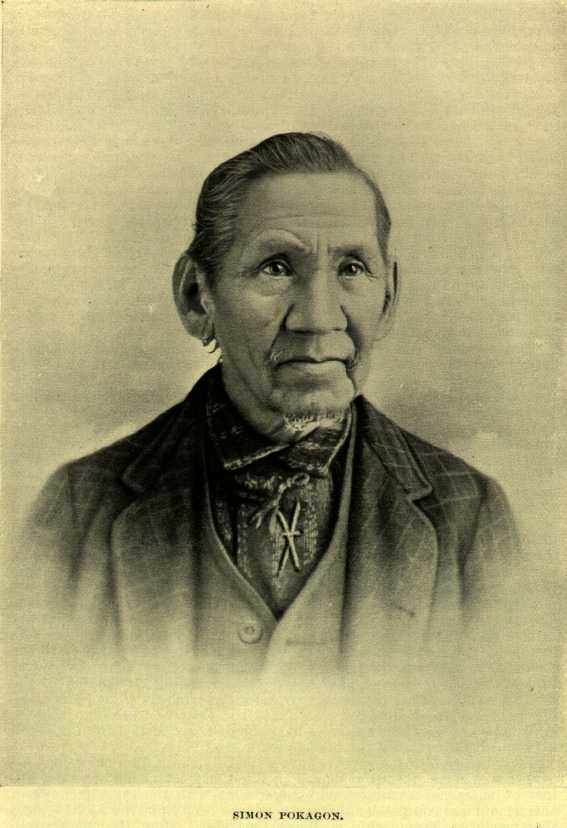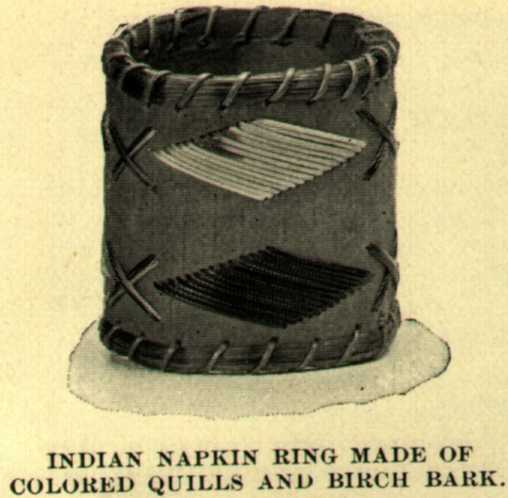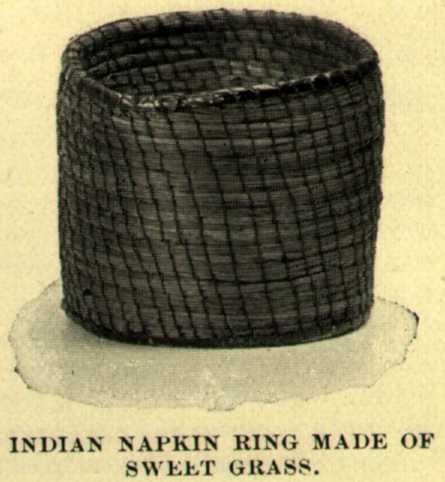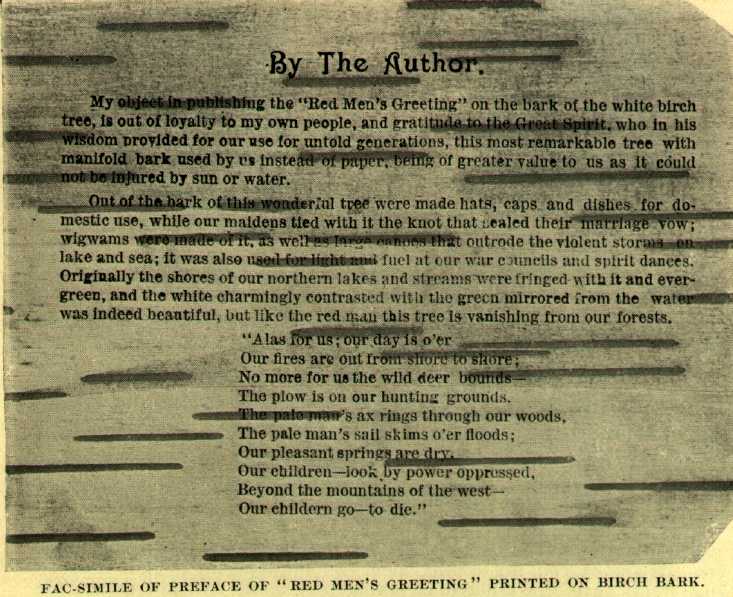| "An Interesting Representative of a Vanishing Race | ||
AN INTERESTING REPRESENTATIVE OF A
VANISHING RACE.
—
BY B. O. FLOWER.
—
One of the most interesting characters at the World's Fair at Chicago was the simple-hearted and earnest champion of his people, Simon Pokagon, chief of the now small tribe of Pottawatomie Indians. This tribe, it will be remembered, sprang from the powerful Algonquin family.
There was a peculiar, if gloomy, interest attached to the appearance as well as the address of this chief of a vanishing tribe and race, owing to the fact that in the boyhood of this patriarch the very spot occupied by Chicago was the home of the Indian, and where to-day stand the palatial residences of such men as George H. Pullman, Marshall Field, and Philip D. Armour, was the scene of the massacre of the garrison of Fort Dearborn by the Pottawatomies. In this connection I desire to quote a graphic description of the past and present relating to this memorable place as given by Mr. W. T. Stead.*
On the rim of the shore of Lake Michigan, on a spot then a desolate waste of sand hills, but now crowded with palaces, stands, leafless and twigless, the trunk of an old cottonwood tree, which marks the site of the massacre of the garrison. Four score years and more have passed since the thirsty sand drank the life-blood of the victims of that Indian war, but still the gaunt witness of the fight looks down upon the altered scene. In 1812, when the British were at war with the French in Europe, our Canadian representatives were busy fighting and diplomatizing against the French and their allies on the Great Lakes. The Americans had struck in on their own account on the side of the French, and the British had just whipped them out of Detroit and Michigan. War is war, and British and Americans fought on, each using as best it could the Indian tribes which swarmed in the unsettled country. The British made allies of Tecumseh, the great chief of the Pottawatomies, and Fort Dearborn, the American outpost at Chicago, became the immediate objective point of the allies after the Americans had been driven out of Detroit and Michigan. The officer in charge, Capt. Heald, a weak incompetent, decided to evacuate by arrangement with the Indians. Whether this decision was right or wrong, he carried it out in the worst possible way. He first summoned the Indians to a council and promised them all the goods in the fort, including the ammunition and fire-water, and then broke his word by throwing all the powder and shot down a well and emptying the liquor into the river. The Indians, furious at

Simon Pokagon
[Description: A man wearing a plaid coat over a grey vest and patterned shirt stitched with a large cross.]The sculptor by a happy inspiration has selected as his motif the one incident of that bloody fray that possesses other than a gory interest. While the Pottawatomies were scalping or tomahawking the palefaces, regardless either of sex or age, Mrs. Helm, the daughter of Mr. Kinzie, the patriarchal settler of early Chicago, was rescued from imminent death by Black Partridge, an Indian chief who had long known and loved her father. The group on the summit of the pedestal represents Mrs. Helm desperately struggling to seize her assailant's scalping-knife, while the splendid chief, Black Partridge, intervenes to snatch her from her impending doom. The surgeon, who was slain, is receiving his death-blow at her feet, while a frightened child weeps, scared by the gleam of the tomahawk and the firing of the muskets. The bas-reliefs, which are not in very much relief, tell the story of the evacuation, the march, and the massacre, and enable the least imaginative observer, as he looks out over the gray expanse of the lake, to picture something of the din and alarm of that bloody August day, and to recall, too, something of the elements of heroism and of humanity which redeemed the grim tale of Indian war.
With the mind full of the Pottawatomies and their tomahawks, pondering upon the possibilities of latent goodness surviving in the midst of the scalping-knife savagery of the redskin tribes, you tear yourself away from the traditions of Black Partridge, the Kinzies, and the rest, and find yourself confronted by the palaces of millionnaires. Mr. George M. Pullman's stately mansion stands in the shade of the cottonwood tree, his conservatory is erected upon the battle-field, and he lives and dines and sleeps where the luckless garrison made its last rally. Prairie Avenue, which follows the line of march, is a camping-ground of millionnaires. With an area of five blocks forty of the sixty members of the Commercial Club have established their homes. Mr. Marshall Field and Mr. Philip Armour live near together on the east side of the avenue a little further south. Probably there are as many millions of dollars to the square inch of this residential district as are to be found in any equal area on the world's surface. It is the very Mecca of Mammon, the Olympus of the great gods of Chicago.
What strange instinct led these triumphant and militant chiefs of the Choctaw civilization of our time to cluster so thickly around the bloody battle-field of their Pottawatomie forbears? "Methinks the place is haunted," and a subtle spell woven of dead men's bones attracts to the scene of the massacre the present representatives of a system doomed to vanish like that of the redskins before the advancing civilization of the new social era. Four score and two years have hardly passed since the braves of Tecumseh slew the children in the Dearborn baggage wagon; but the last of the Pottawatomies have long since vanished from the land over which they roamed the undisputed lords.
Long before four score years have rolled by the millionnaire may be as scarce as the Pottawatomie, and mankind may look back upon the history of trusts and combines and competitions with the same feelings of amazement and compassion that we now look back upon the social system that produced Tecumseh and Black Partridge. How the change will come we may not be able to see any more than the Pottawatomies were able to foresee the value of the real estate on which Chicago was built. They parted with it in fee simple for three cents an acre, and did not get

Indian napkin ring made of colored quills and birch bark.
[Description: A napkin ring. It is decorated with white and black diamond shapes, and stitched crosses.]
Indian napkin reing made of sweet grass.
[Description: A woven napkin ring.]On Chicago Day Liberty bell was rung for the first time during the Exposition,* and Chief Pokagon was selected to ring the bell and also to deliver an address. During the course of his remarks, which were delivered in the presence of more than half a million people, he made the following touching and suggestive utterances:
Through the untiring efforts of a few friends of another race I greet you. If any of you, my countrymen, feel the sting of neglect because your rights have been ignored in taking part in the World's great Fair until now, I beseech you to lay aside all bitterness of spirit, and with hearts so pure and good that these noble mothers and daughters that have so labored in our behalf for this may rejoice that the kind seed they have sown has not fallen on dry and barren ground.
Let us not crucify ourselves by going over the bloody trails we have trod in other days; but rather let us look up and rejoice in thankfulness in the present, for out of the storm-cloud of darkness that is round about us we now see helping hands stretched out to aid and strengthen us, while above the roar and crash of the cyclone of civilization are heard many voices demanding that to the red man justice must be done.
In my infancy I was taught to love my chief and tribe; but since then the great West has been swallowed up by the white man, and by adoption we are the children of this great Republic, hence we must teach loyalty to this nation to our children, and solemnly impress them that the war-path leads but to the grave.
The question comes up to us again and again, "What can be done for the best good of the remnant of our race?" The answer to me is plain and clear, and it matters not how distasteful it may seem to us. We must give up the pursuits of our fathers. However dear we love the chase we must give it up. We must teach our children to give up the bow and arrow that is born in their hearts; and in place of the gun we must take the plough and live as the white men do. They are all around about our homes. The game is gone never to return; hence it is vain to talk about support from game and fish. Many of our people are now
My object in publishing the "Red Man's Greeting" on the bark of the white birch tree, is out of loyalty to my own people, and gratitude to the Great Spirit, who in his wisdom provided for our use for untold generations, this most remarkable tree with manifold bark used by us instead of paper, being of greater value to us as it could not be injured by sun or water.
Out of the bark of this wonderful tree were made hats, caps and dishes for domestic use, while our maidens tied with it the knot that sealed their marriage vow; wigwarms were made of it, as well large canoes that outrode the violent storms on lake and sea; it was also used for light and fuel at our war councils and spirit dances. Originally the shores of our northern lakes and streams were fringed with it and evergreen, and the white charmingly contrasted with the green mirrored from the water was indeed beautiful, but like the red man this tree is vanishing from our forests.
Our fires are out from shore to shore;
No more for us the wild deer bouns—
The plow is on our hunting grounds.
The pale man's ax rings through our woods,
The pale man's sail skims o'er floods;
Our pleasant springs are dry.
Our children—look, by power oppressed,
Beyond the mountains of the west—
Our children go—to die."
What they have done we all can do. Our children must learn. They owe no allegiance to any clan or power on earth except the United States. They must learn and love to wear the stars and stripes, and at all times to rejoice that they are American citizens.
Our children must be educated and learn the different trades of the white men. Thanks to the Great Spirit, this government has already established a few schools for that purpose, and to learn of the success you have but to visit the Indians' school in these grounds, examine the work of the children, see the different articles they have made, examine their writing-books, and you will be convinced that they will be able to compete with the dominant race.
I was pained to learn that some who should have been interested in our people discouraged our coming to the Fair, claiming openly that we are heartless, soulless, and godless. Now let us all as one pray the Great Spirit that he will open the eyes of their understanding and teach them to know that we are human as well as they; teach them to know that
There is a secret place, which God doth hold;
And though the storms of life do war around,
Yet still within His image fixed is found.
I am getting to be an old man. I often feel one foot is uplifted to step into the world beyond. But I am thankful that the measure of my days has been lengthened out, that I am able to stand before you in this great congress of people, in this four hundredth year of the white man's advent in our fathers' land.
The breadth of thought and the innate spirituality which permeate this address are no less marked than the stoical acceptance of conditions with an earnest determination to make the best of circumstances as they exist.
Some months prior to the opening of the Exposition Chief Pokagon published a little booklet entitled "The Red Men's Greeting," printed on the bark of the white birch tree. This "Greeting" was pitched in a minor key. The plaintive note of the representative of a warrior race who had beheld the glory of his people vanish characterizes it throughout. It is so entirely out of the ordinary in all particulars that I reproduce in this paper the author's preface enlarged and photographed from a leaf of the birch bark on which it is printed.
Mrs. Flower reviewed this work in THE ARENA on its appearance, which called forth an interesting letter, from which I quote the following extract:
The enclosure referred to above is one of the most characteristic, and in some particulars unique, sketches I have read in years, simple in treatment and revealing in a marked degree the child mind, while carrying with it the keen perception of the true son of the forest, coupled with ethical deductions as relating to man's life which suggest the ancient stoic philosopher, as will be seen by the copy given below.
The News of Plymouth, Mich., on Feb. 8, 1893, observed editorially that "the elder Pokagon was one of the chiefs to whom was ceded by treaty the ground on which Chicago now stands, and which was afterward conveyed back to the government through conniving of the swindling agents, for a consideration that amounted to about three cents per acre."
| "An Interesting Representative of a Vanishing Race | ||
